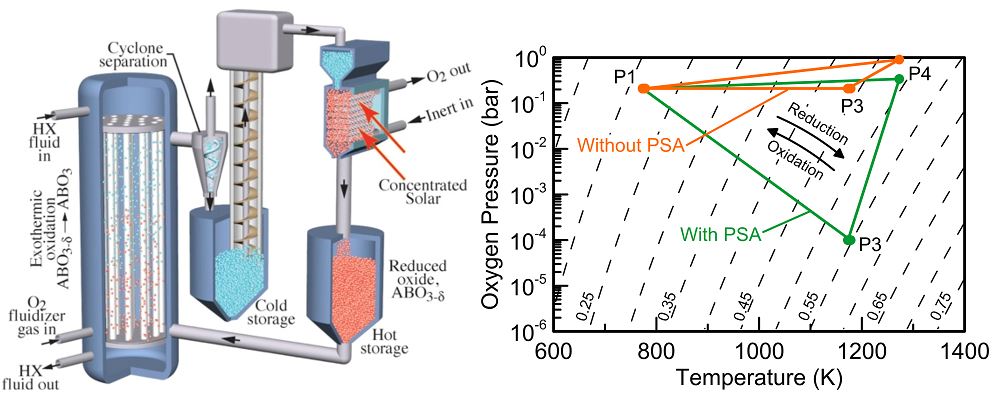Renewables and Grid-Energy Storage Systems
High-Temperature Thermochemical Storage With Redox-Stable Perovskites For Concentrating Solar Power
The attractiveness of renewable resources, such as concentrated solar power, will be greatly enhanced if they can increase their capacity factor and be dispatchable during peak electricity demand periods. Cost effective and energy dense storage is one critical enabling technology to help achieve widespread implementation of concentrating solar energy power plants. The ability of central receiver concentrating solar power (CSP) technologies to employ thermal energy storage (vs. electrical energy storage) makes the technology compelling despite the lower thermal efficiency and currently higher costs of the plant. Challenges in achieving low cost/high performance thermal energy storage have been related to both the relatively low temperature limit for heat transfer fluids and the associated low energy density of storing only sensible thermal energy in these media. Thus, this project aims to address some of these limitations by augmenting sensible energy storage with chemical energy using redox cycling of dense perovskite oxide particles. The implementation of thermochemical energy storage in concentrated solar power applications has the potential to decrease the levelized cost of electricity making the technology competitive with fossil fuels. However, there are intrinsic difficulties in thermochemical processes where oxidation and reduction reactions will only preceded if they are energetically favorable. Perovskite oxide redox thermodynamics have shown energy storage potentials approaching 750 kJ/kg when coupled with the large temperature swings achieved by a high temperature particle based receiver. Additionally, the high temperature nature of the particle receiver allows for CSP to implement advance power cycles such as supercritical CO2 or air Brayton.
The multifaceted nature of this project seeks to 1) identify a perovskite oxide composed primarily of earth abundant materials and capable of delivering the desired energy density with sufficiently fast kinetics, 2) develop reduced order models to characterize the performance of the energy storage subsystem and interface with high performance power cycles, 3) design a particle receiver using high-fidelity CFD models, and 4) perform techno-economic analyses.
FUNDING: NREL

Publications
- K.J. Albrecht, R.J. Braun, “Thermodynamic Analysis of Non-Stoichiometric Perovskites as a Heat Transfer Fluid for Thermochemical Energy Storage in Concentrated Solar Power,” Proceedings of the ASME 2015 9th International Conference on Energy Sustainability, 49409 (2015).
Current Projects
Past Projects
Selected Publications in This Research Area
E.P. Reznicek, J.F. Hinze, G.F. Nellis, M.H. Anderson, R.J. Braun
Energy Conversion and Management, 229:1113678, (2021)
E.P. Reznicek, J.F. Hinze, L.M. Rapp, G.F. Nellis, M.H. Anderson, R.J. Braun
Energy Conversion and Management, 218:112921 (2020)
Simulation of sCO2 Recompression Brayton Cycles with Regenerators
E. Reznicek, R.J. Braun
Proceedings of the 6th International Supercritical CO2 Power Cycles Symposium (2018)
Simulation of Supercritical Carbon Dioxide Brayton Recompression Cycles with Regenerative Heat Exchangers
E. Reznicek, R.J. Braun
Proceedings of the ASME 2017 11th International Conference on Energy Sustainability, 3946 (2017)
Optimized Dispatch in a First-Principles Concentrating Solar Power Production Model
M.J. Wagner, A.M. Newman, W.T. Hamilton, R.J. Braun
Applied Energy, 203:959–971, (2017)
Modeling and Simulation of Regenerative Heat Exchangers for Supercritical CO2 Cycles
E. Reznicek and R.J. Braun
Proceedings of the ASME 2016 10th International Conference on Energy Sustainability, 59869 (2016)
C. Wendel, P. Kazempoor, R.J. Braun
Journal of Power Sources, 301:93–104, (2016)
S.H. Jensen, C. Graves, M. Mogensen, C. Wendel, R.J. Braun, G. Hughes, Z. Gao, S.A. Barnett
Energy and Environmental Science, 8:2471–2479, (2015)
C. Wendel, P. Kazempoor, R.J. Braun
Journal of Power Sources, 276:133–144, (2015)
C. Wendel, R.J. Braun
Journal of Power Sources, 283:329–342, (2015)
Thermodynamic Analysis of Non-Stoichiometric Perovskites as a Heat Transfer Fluid for Thermochemical Energy Storage in Concentrated Solar Power
K.J. Albrecht, R.J. Braun
Proceedings of the ASME 2015 9th International Conference on Energy Sustainability, 49409 (2015)
Model Validation and Performance Analysis of Regenerative Solid Oxide Cells: Electrolytic Operation
P. Kazempoor, R.J. Braun
International Journal of Hydrogen Energy, 39:2669–2684, (2014)
P. Kazempoor, R.J. Braun
International Journal of Hydrogen Energy, 39:5955–5971, (2014)
View Other Research Areas:
HIGH-TEMPERATURE FUEL CELLS FOR MOBILE AND STATIONARY APPLICATIONS
MODELING AND SYSTEMS ANALYSIS OF ALTERNATIVE FUEL PRODUCTION AND UTILIZATION SYSTEMS